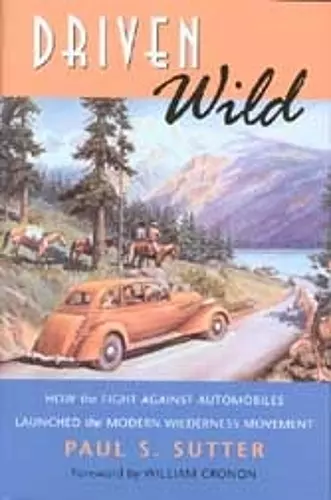Driven Wild
How the Fight against Automobiles Launched the Modern Wilderness Movement
Format:Paperback
Publisher:University of Washington Press
Published:1st Jan '05
Currently unavailable, and unfortunately no date known when it will be back

Traces the intellectual and cultural roots of the wilderness movement from 1910 through the 1930s
Demonstrates that the movement to protect wilderness areas reflected a belief that the modern forces of capitalism were eroding the ecology of North America, and American values
In its infancy, the movement to protect wilderness areas in the United States was motivated less by perceived threats from industrial and agricultural activities than by concern over the impacts of automobile owners seeking recreational opportunities in wild areas. Countless commercial and government purveyors vigorously promoted the mystique of travel to breathtakingly scenic places, and roads and highways were built to facilitate such travel. By the early 1930s, New Deal public works programs brought these trends to a startling crescendo. The dilemma faced by stewards of the nation's public lands was how to protect the wild qualities of those places while accommodating, and often encouraging, automobile-based tourism. By 1935, the founders of the Wilderness Society had become convinced of the impossibility of doing both.
In Driven Wild, Paul Sutter traces the intellectual and cultural roots of the modern wilderness movement from about 1910 through the 1930s, with tightly drawn portraits of four Wilderness Society founders--Aldo Leopold, Robert Sterling Yard, Benton MacKaye, and Bob Marshall. Each man brought a different background and perspective to the advocacy for wilderness preservation, yet each was spurred by a fear of what growing numbers of automobiles, aggressive road building, and the meteoric increase in Americans turning to nature for their leisure would do to the country’s wild places. As Sutter discovered, the founders of the Wilderness Society were "driven wild"--pushed by a rapidly changing country to construct a new preservationist ideal.
Sutter demonstrates that the birth of the movement to protect wilderness areas reflected a growing belief among an important group of conservationists that the modern forces of capitalism, industrialism, urbanism, and mass consumer culture were gradually eroding not just the ecology of North America, but crucial American values as well. For them, wilderness stood for something deeply sacred that was in danger of being lost, so that the movement to protect it was about saving not just wild nature, but ourselves as well.
"Sutter ably demonstrates that all four founders of the Wilderness Society feared that roads and cars were destroying the last remnants of American wilderness, abetted by government's willingness to encourage modernization and tourism. Nicely written; extensively referenced."
* Choice *"Driven Wild is a fresh look at the origins of the wilderness movement that deserves a place on the shelf of both geographers and historians..An excellent addition to conservation literature."
* Historical Geography *"Driven Wild is an outstanding scholarly achievement and is one of the best books ever written about environmental politics..[It] deserves to be read by a wide audience; there is no doubt that its conclusions are important and will frame further discussions about this aspect of American environmental history and policy."
* Electronic Green Journal *"A superb study..Sutter's historical reexamination of the origins of wilderness policy is the most sophisticated and thorough entry in the historiography of wilderness that I have yet seen. As such, it is a must read for environmental historians."
* H-Net Book Review *"Driven Wild is essential reading for all those interested in the history of conservation and the cultural development of the wilderness ideal. It ably illustrates how far the automobile shapes not just our cities and our civilization, but also our visions of nature."
* The Journal of Arizona HistoISBN: 9780295982205
Dimensions: unknown
Weight: 567g
383 pages